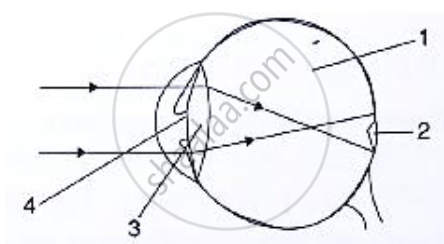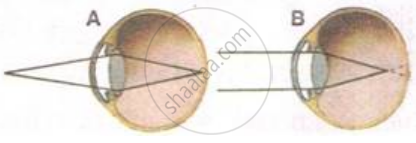Advertisements
Advertisements
प्रश्न
An eye has a far point of 2 m. What type of lens in spectacles would be needed to increase the far point to infinity? Also calculate the power of lens required. Is this eye long-sighted or short-sighted?
उत्तर
The far point of an eye can be increased by wearing spectacles with concave lens. In order to find the power of the concave lens required, we have to first calculate its focal length.
Given that the far point of the short-sighted person is 2 m in front of the eye (the person can see objects kept at infinity if the images of the objects are formed at the person's own far point of 2 m from the eye).
`u=oo("the distance of the object")`
`v=-2m("the far point of the defective using the formula ")1/f=1/v-1/u`
f=? (focal length)
The focal length can be calculated using the formula `1/f=1/v-1/u`
Substituting the values in the formula, we get `1/f=1/-2-1/oo=(-1)/2 ("Sinc e, 1/oo=0")`
∴ f=-2 m
Now that we know the focal length of the concave lens required, its power can be calculated.
Power `P=1/f` (for f in meters)
∴` P=1/-2=-0.5 D`
Hence, the power of the concave lens required to rectify the defect is -0.5 D.
This eye is short-sighted.
APPEARS IN
संबंधित प्रश्न
What is the other name for
hypermetropia
A man can read the number of a distant but clearly but he finds difficulty in reading a book.
What type of spectacle lens should he use to correct the defect?
The defect of vision in which the eye-lens of a person gets progressively cloudy resulting in blurred vision is called:
(a) myopia
(b) presbyopia
(c) colourblindness
(d) cataract
The near point of a long-sighted person is 50 cm from the eye.
(a) Can she see clearly an object at:
(i) a distance of 20 cm?
(ii) at infinity?
A person can read a book clearly only if he holds it at an arm's length from him. Name the defect of vision:
if the person is an old man
Name the following:
The photosensitive pigment present in the rods of the retina.
Differentiate between members of the following pair with reference to what is asked in the bracket.
Rods and cones (sensitivity).
Given below is a diagram depicting a defect of the human eye. Study the same and answer the question that follow:

Name the defect shown in the diagram.
Have a look at the posture of this woman who is reading a book and answer the questions which follow:

What are the two conditions shown in sections A and B of the eye as applicable to her?
A person is unable to see clearly a poster fixed on a distant wall. He however sees it clearly when standing at a distance of about 2 m from the wall.
- Draw ray diagram to show the formation of image by his eye lens when he is far away from the wall.
- List two possible reasons of this defect of vision.
- Draw ray diagram to show the correction of this defect using appropriate lens.
